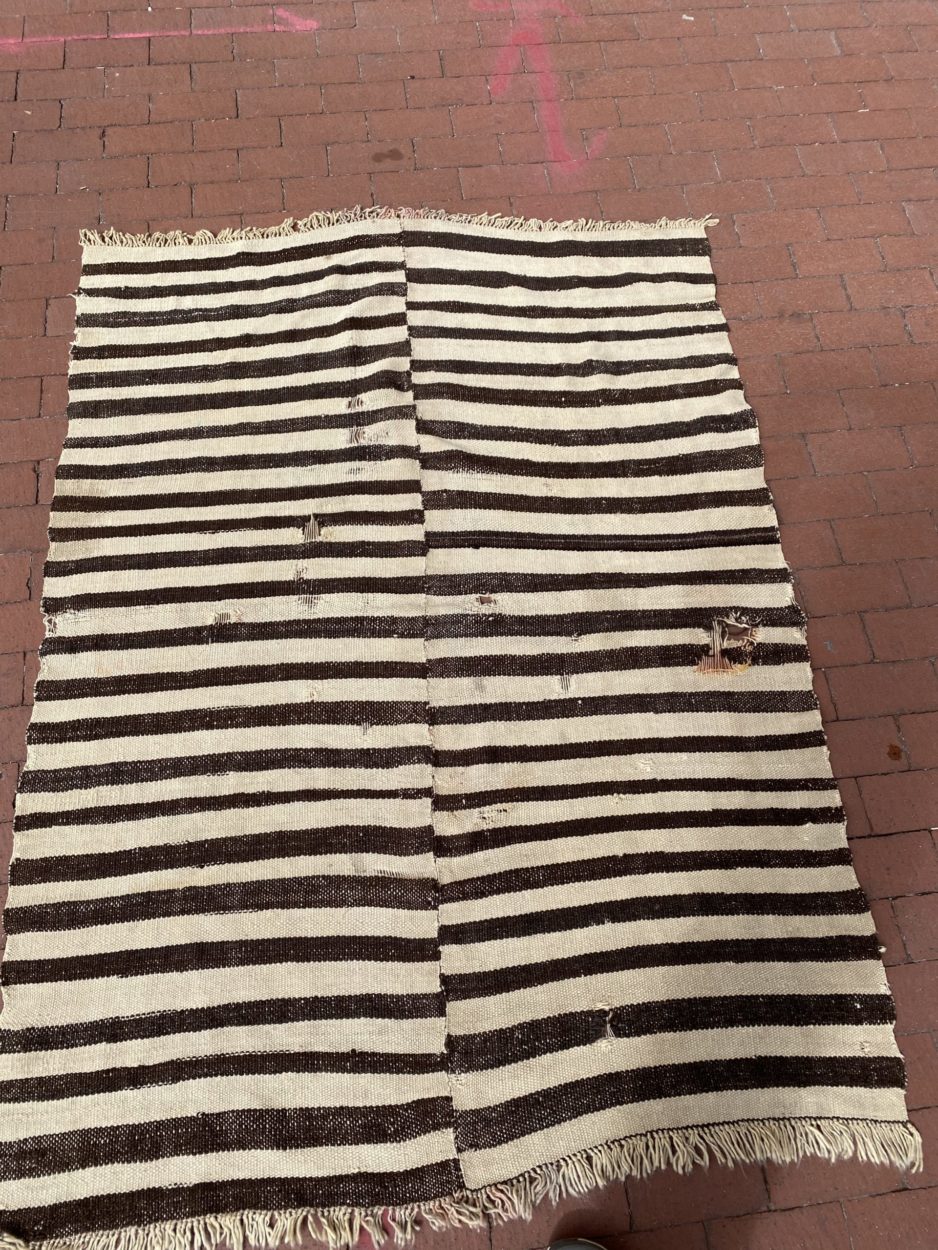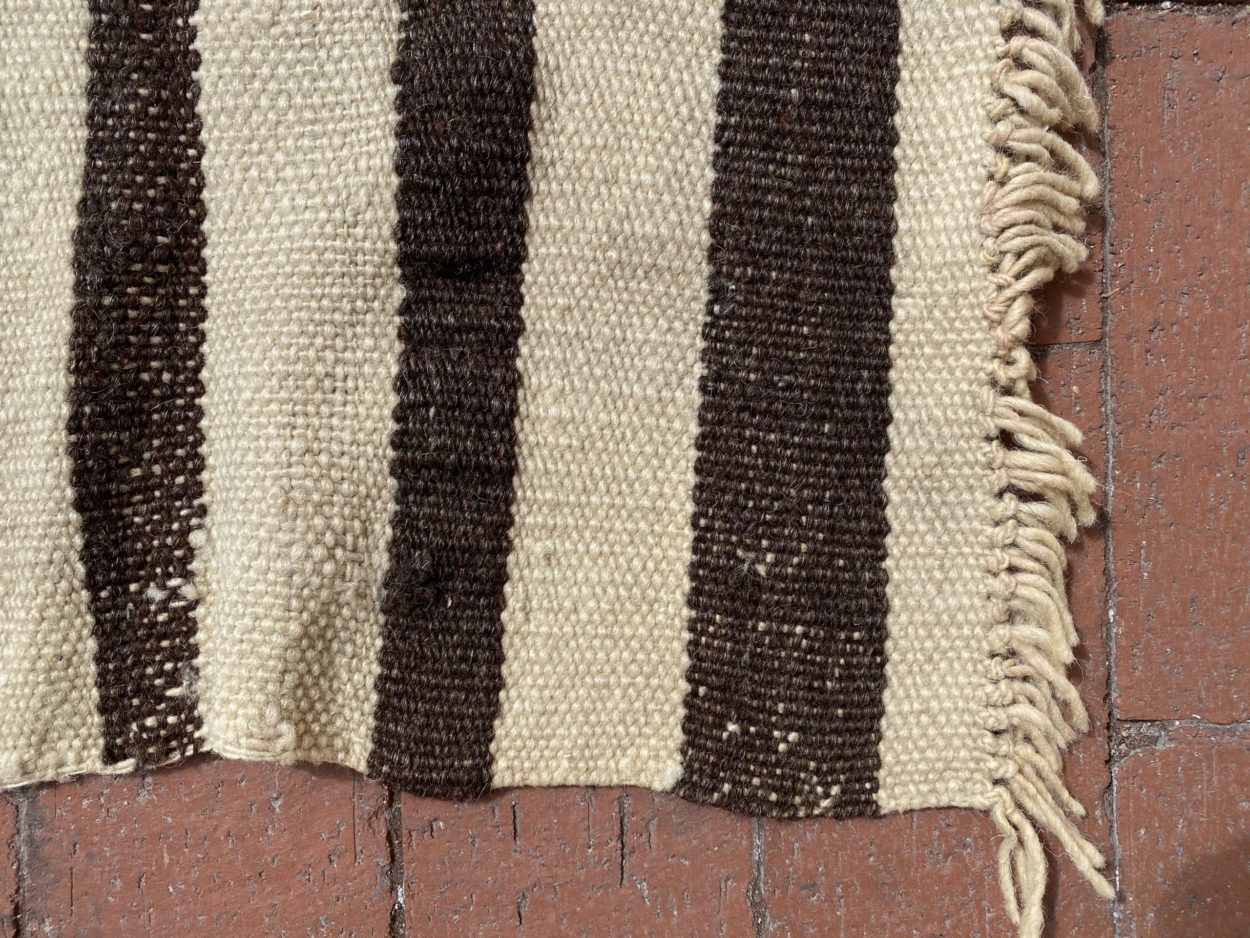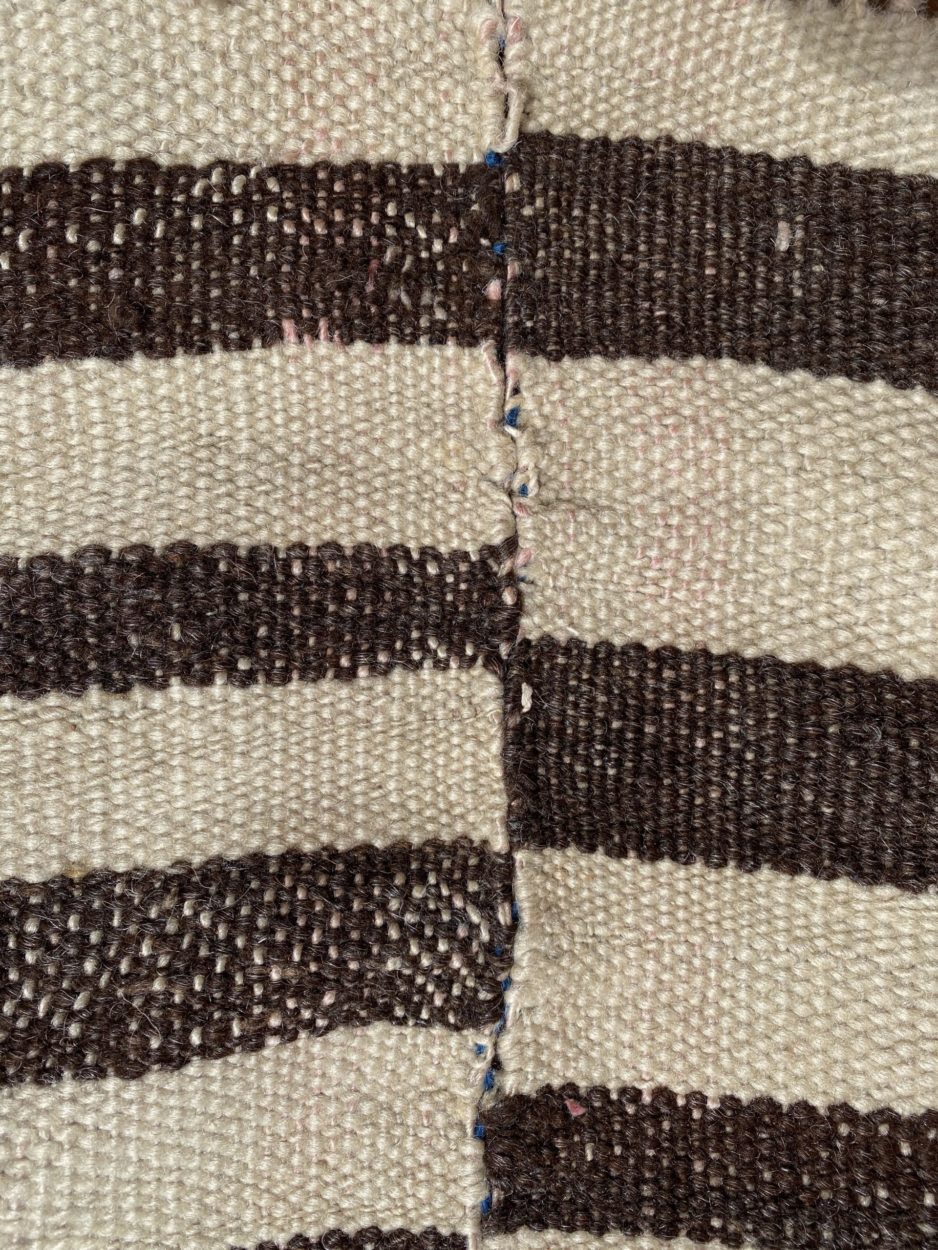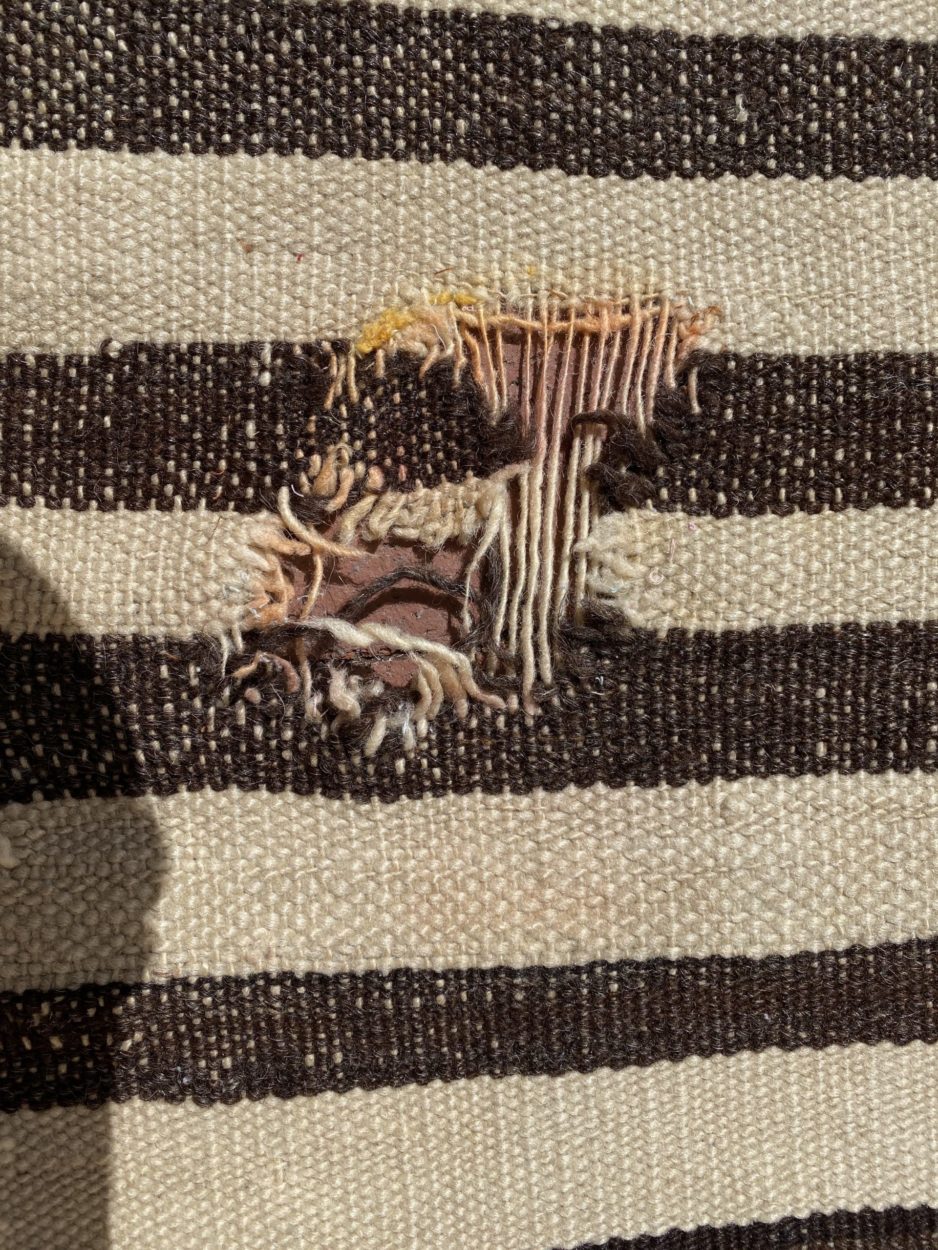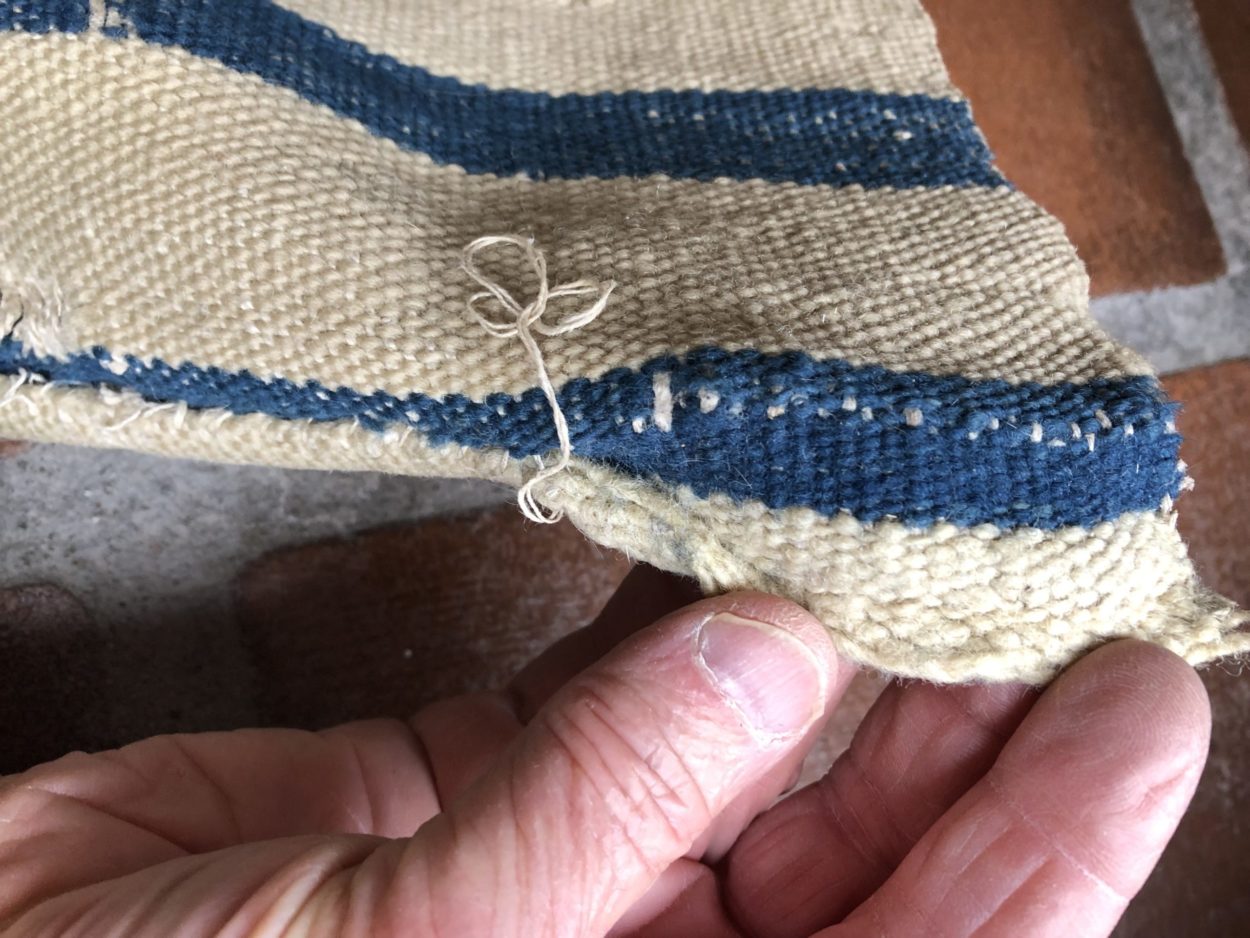
Two Early Rio Grande Blankets
- by Jamie Compton
- in A closer look...
- posted April 1, 2020
Nothing gets me more excited than discovering early textiles of the Southwest. I’m not talking about late 19th or even mid 19th century blankets. I’m talking more like 17th (none are known to exist through documentation) and 18th as well as early 19th century weavings. I’m always on the prowl for anything that might fit this description. I want to present to you here, in this blog, two Rio Grande blankets that I believe fit the bill.
Please realize that this adventure is based only on my experience, my past readings, and my desire to open the discussion to ponder what might be unusually early SW textiles. I am hoping here to put out my ideas to create more discourse on the topic, so I encourage any and all reactions to my ideas. I also encourage those having blankets that they suspect may be early to please reach out and share with me what you have. I would love to go over the blankets with you either by photo or, if possible, in person.
Let me first describe the characteristics that qualifies a potentially early 19th century, or earlier, weaving.
Purely Banded Blankets
1. Simple, repetitive banding is the first visual clue. The banding can range anywhere from one to two wefts of yarn wide to upwards of 2 to 4 inches wide. This would include the classic Navajo First Phase blanket, which we believe is a design coming out of the yet earlier Pueblo banded weavings. The banding will either be in natural brown or natural indigo. The background banding will typically mimic the colored banding and will usually be natural white or cream-colored wool weft. These qualities can be established purely by vision and requires no touching. I say this since those that I have found were often first discovered online with only photos as my reference.
Churro Wool as Butter
2. The second quality to suggest an early age is the color of the white wool, whether it be the weft or the warp. Before the Spanish arrived to the Southwest, there were no sheep and thus no wool. All weaving was done with plant-based material such as cotton or yucca fibers. The Spanish brought churro sheep in the mid 16th Century and it is this breed that remained until the mid 1860s when many of them were killed off and replaced with a different breed. The churro sheep grew long fibered fleece that was relatively clean of grease and easy to prepare and weave with. The later breeds replacing the churro made for a kinkier wool that was more greasy and harder to prepare and weave with. Another distinguished feature of this early churro wool is the color of the white wool. This white color was not actually white, but had more warmth in it, like a touch of butter or cream. I have never seen early churro wool represented as truly white wool. It is always off white and can be from a very soft cream hue to almost a strong butter yellow hue. This second feature then looks to see if the white wool is indeed this warm, creamy color. I often feel, perhaps untrue, that the more golden this white wool is, the earlier the blanket may be.
Weft or Warp Faced Blanket?
3. The third quality suggesting an early age is how the wool wefts are laid down over the warps. This feature is possible to discern by photos as well. What’s presented here is a wool weft that is not packed down tight together over the warps, as is typically seen after the middle of the 19th century. In this earlier situation, more warp shows through between the wefts. My layman’s experience tells me that the earliest textiles were not weft faced weaves, but equally warp and weft faced. While I believe that weft faced blankets were also woven, I feel that a greater number of them, especially earlier ones, show a lot more warp through the weft.
How Tight is the Weft Spun?
4. The fourth point is that the weft is typically not overly spun tight. Later 19th century blankets, typically after around 1870, show an increase spin on the wool wefts. While this feature can also be sensed by photos, this is the sort of thing that really wants a hands-on feel. Wefts that are less spun are lighter in weight. The light twist to the yarn creates less use of wool yet allows for more fluffiness.
What’s the Gut Feel?
5. The fifth and last point has to do with a more layered and complicated quality that is all about the wool. The idea here is that early wool has an energy or feel to it that later wool does not share. For a novice, or someone that has touched few early blankets, this will not make much sense. However, a novice that is sensitive to age and energy will likely also feel the difference. This “feel” of the wool takes on not just the parts but also the whole. It’s a view of the blanket that requires softening the vision to include so much more than that single sense. This is a gut feeling, and is one that takes on the deeper quality of us as animals that have lived for thousands of years and how this very fact, if allowed to be present, can show so much more than our thinking mind can know. This experience, naturally, requires one to be with the blanket, at different times, in varying moods, and in different light and even in the dark of night. Gathered together from our experience is a culminating gut feeling that suggests, and sometimes screams, age.
Two Early Rio Grande Blankets
While the times have changed with New Mexico’s “shelter in place” for the corona virus, I still have a bit of activity in my gallery. Last week, while the gallery was still open, a person came in with a very early, simple banded Rio. It came out of a long-lived historic Hispanic family in Northern New Mexico. It’s two pieces joined at the center and is a simple alternating banded pattern of brown and white wool. The seam down the center is stitched with a single ply yarn of deep indigo blue. It’s very interesting that this blanket has single ply handspun wool and not two-ply, as most all Rio Grande blankets have. This suggest that the blanket may have bee woven by a Navajo or Pueblo person.
The second Rio Grande blanket I found over a year ago at an auction on the East Coast. While I am not 100 % certain this is a Rio Grande, it has many of the attributes. This blanket is also in two halves and is a simple banded pattern of alternating indigo blue with cream white single plied wool. The warp is a two-ply handspun cotton, one of the features of this blanket that suggests a very early age.
I am very excited about both of these blankets, as I believe, or want to believe, that they are early examples, earlier than likely known, and while I cannot prove it by documentation, my gut tells me so.
The following is a group of photos (taken by me, unprofessionally and not in the best form, but then I’m too impatient to wait for the professional photographer) along with descriptions of what I think contributes to my notions.
Brown and White Banded Rio Grande Blanket
The above blanket measures 73 by 54 inches not including the fringe. Here one can see the simple banded pattern of natural brown wool alternating with a creamy golden colored white. This blanket was patched over the years with more contemporary cloth which has bled the dyes onto the wool. Notice how from this bigger view one can see a fair number of white warps showing through the brown weft bands. This shows how loosely laid the wefts are put down on top of the warps.
This above close up of one of the corners shows how loose the weft was put down over the warps. One can also get a sense of how the brown, and especially the white wefts are not spun tight. There is a sense that the wefts have flattened over time in their airiness, something that a tightly spun weft would not do. The warps, for extra strength, are always spun tight in contrast to the wefts.
Here one can see a detail of the center seam. Looking carefully, you can see the single ply of indigo blue yarn alternating back and forth along with a single ply of cream white wool. You can also see how some of the wool has inherited red dye from previous cloth that at one time patched the holes on this blanket. The luster of the early wool shows here, a factor of both the churro wool as well as the age taken on by it.
This above detail showing a larger hole also shows the single ply warps. One can tell that these warps are more tightly spun. Their single ply nature, instead of two-ply which is a certain for any Rio Grande blanket, suggests that a Navajo or Pueblo person could well have woven this blanket within a Spanish Colonial household. These types of blankets are called Slave Blankets, since the Spanish often housed, either for pay or as slaves, Native peoples to do their home chores.
The fifth description I have above on the “feel” of an early blanket can be considered from this photo. The sheen seen on the wool, the glossy look and the random shifting of size of weft all help to contribute to my “sense” that this is an early blanket.
An Indigo and Cream White Banded Rio Grande Blanket
The above photo shows the banded indigo blue and cream white blanket woven in two parts. It measures 85 x 58 inches. The ends were rolled up when found and while the ends have since been unrolled, this photo shows the ends still rolled. The two parts are joined only in a few spots, with a two-ply handspun cotton yarn. This same cotton yarn was used to secure the rolled-up ends. Here the background white takes up a good deal more space than the indigo bands, making this instead an indigo banded blanket over a white background.
This blanket shows similar spacing between the wefts as found in the previous brown banded blanket. The wefts are loosely put down and are not packed in, showing the warps on a regular basis. The warps show through just as much in the white weft, but the contrast is not there as when the blue wefts pass over the white warps. One can also see how white the two-ply warps are, which are cotton, in contrast to the yellowish wool weft.
This above close up shows many qualities. One can see the two-ply cotton warp popping through the indigo weft. You can also see the soft spin to the weft – it also has been flattened over time as with the previous blanket. The detail being shown here is my beginning to unravel the ends bound with two-ply handspun cotton yarn. Laying just left of my thump is the cotton yarn I have unraveled from the binding, showing the blanket unrolled to its very end. Looking to the left of this piece of yarn you can see how this cotton yarn continues its stitching into the rolled end to keep it secure.
While this blanket presents to me overall as a Rio Grande blanket, one of the qualities that makes me question this is how the ends are finished. It appears there are no knots with the ends of the cotton warps, but instead a tucking of the warps back into the wool weft. The cotton suggests an earlier age, as there are a small handful of purely all cotton woven Rio Grande blankets out there. The other considerations for the origins of this blanket would be Eastern US seaboard 18th Century or what is now Mexico. Further research will need to be done to further document this as a Rio Grande. I encourage any curious folks out there to contact me with ideas.
Thank you for wading your way through my writings. I encourage any questions about my ideas. Please reach out by either calling 505 699-0323 or emailing me: jamie@jamescomptongallery.com. My best to you during this pandemic, and a safe and curious path of discovery as we all chart new paths with our lives.

